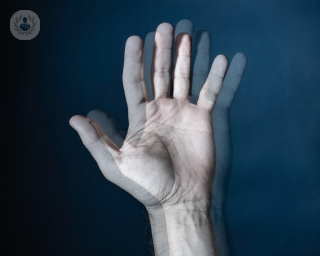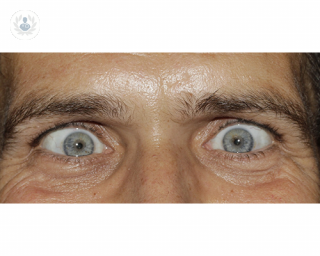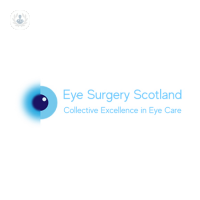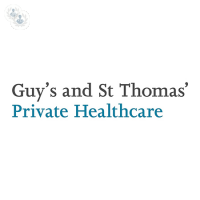What is strabismus?
Strabismus, also known as a 'squint', means that the eyes are not aligned. It can cause difficulties with social interaction, and a person's self-confidence. Strabismus can be classified into three types, based on the direction of the eyes:
- Convergent strabismus : One eye is looking straight, the other is looking towards the nose.
- Divergent strabismus : One eye is looking straight, the other is looking outward.
- Vertical strabismus : One eye is looking straight, the other eye is looking up or down.

Symptoms of strabismus:
Symptoms of strabismus may include:
- Crossed eyes
- Double vision
- Reduced vision in one eye (amblyopia)
- Uncoordinated eye movements (eyes do not move together)
- Absent or reduced depth perception
How is it diagnosed?
An orthoptist will carry out a detailed assessment of visual function, eye alignment and eye movements. This is followed by a check of the health of the eye - both front and back parts - by an ophthalmologist.
These assessments may include:
- Visual acuity test (tests how well you can read from far distance and close-up)
- Fine 3D vision
- Observation of the light refraction of the cornea (clear window at the front of the eye)
- Cover/uncover test
- Examination of the front part of the eyes
- Examination of the back part of the eye (retina and optic nerve)
Should there be any specific concerns, a basic assessment of brain and cranial nerve function (neurological) examination will also be performed.
What causes strabismus?
Strabismus can be a developmental defect, manifesting in children, or it can develop from adults, usually as a consequence of a neurological, vascular, or immunological condition, such as:
- Diabetes
- Thyroid disease (Graves' disease)
- Myasthenia gravis (a neuromuscular disease)
- Brain tumours
- Head trauma
- Stroke
Occasionally, strabismus may result following eye surgery, such as cataract surgery, retinal detachment surgery, eyelid surgery, etc. This is usually caused by an improvement in vision, which unmasks a pre-existing strabismus which didn't present before. After retinal detachment or eye socket surgery, strabismus can occur due to inadvertent involvement of one of the eye muscles.
Treatments for strabismus
Early treatment is important, particularly in children. Treatment often targets the vision in the affected eye first, as the eye alignment may improve if the eyesight improves. Treatment options may include:
- Glasses
- Wearing an eye patch (to treat amblyopia)
- Eye exercises (for convergence weakness)
- Wearing special glasses with prisms to help with double-vision
- Surgery to strengthen or weaken certain eye muscles
- Botulinum toxin injections to weaken specific eye muscles
Which specialist treats strabismus?
Ophthalmologists diagnose and treat diseases that affect eyes and vision, including eye alignment.
11-13-2012 02-14-2024Strabismus (squint)
Dr Annegret Dahlmann-Noor - Ophthalmology
Created on: 11-13-2012
Updated on: 02-14-2024
Edited by: Conor Lynch
What is strabismus?
Strabismus, also known as a 'squint', means that the eyes are not aligned. It can cause difficulties with social interaction, and a person's self-confidence. Strabismus can be classified into three types, based on the direction of the eyes:
- Convergent strabismus : One eye is looking straight, the other is looking towards the nose.
- Divergent strabismus : One eye is looking straight, the other is looking outward.
- Vertical strabismus : One eye is looking straight, the other eye is looking up or down.

Symptoms of strabismus:
Symptoms of strabismus may include:
- Crossed eyes
- Double vision
- Reduced vision in one eye (amblyopia)
- Uncoordinated eye movements (eyes do not move together)
- Absent or reduced depth perception
How is it diagnosed?
An orthoptist will carry out a detailed assessment of visual function, eye alignment and eye movements. This is followed by a check of the health of the eye - both front and back parts - by an ophthalmologist.
These assessments may include:
- Visual acuity test (tests how well you can read from far distance and close-up)
- Fine 3D vision
- Observation of the light refraction of the cornea (clear window at the front of the eye)
- Cover/uncover test
- Examination of the front part of the eyes
- Examination of the back part of the eye (retina and optic nerve)
Should there be any specific concerns, a basic assessment of brain and cranial nerve function (neurological) examination will also be performed.
What causes strabismus?
Strabismus can be a developmental defect, manifesting in children, or it can develop from adults, usually as a consequence of a neurological, vascular, or immunological condition, such as:
- Diabetes
- Thyroid disease (Graves' disease)
- Myasthenia gravis (a neuromuscular disease)
- Brain tumours
- Head trauma
- Stroke
Occasionally, strabismus may result following eye surgery, such as cataract surgery, retinal detachment surgery, eyelid surgery, etc. This is usually caused by an improvement in vision, which unmasks a pre-existing strabismus which didn't present before. After retinal detachment or eye socket surgery, strabismus can occur due to inadvertent involvement of one of the eye muscles.
Treatments for strabismus
Early treatment is important, particularly in children. Treatment often targets the vision in the affected eye first, as the eye alignment may improve if the eyesight improves. Treatment options may include:
- Glasses
- Wearing an eye patch (to treat amblyopia)
- Eye exercises (for convergence weakness)
- Wearing special glasses with prisms to help with double-vision
- Surgery to strengthen or weaken certain eye muscles
- Botulinum toxin injections to weaken specific eye muscles
Which specialist treats strabismus?
Ophthalmologists diagnose and treat diseases that affect eyes and vision, including eye alignment.


Diplopia: why am I seeing double?
By Miss Stephanie West
2024-12-26
Diplopia is what eye specialists call double vision, a condition that can affect both eyes or just one and causes a person to see two images of a single object. Miss Stephanie West, an ophthalmologist who specialises in treating this condition, outlines what diplopia is and how it can affect people's daily lives. See more


Squint surgery: Costs, benefits, and why it’s worth it
By Mr Nadeem Ali
2024-12-26
Squint surgery is a medical procedure designed to improve misalignment of the eyes, commonly referred to as squint. Here, Mr Nadeem Ali, a distinguished Consultant specialising in Adult Squint and Double Vision Surgery, provides an expert insight into the cost of squint surgery and highlights why its long-term benefits make it a worthwhile investment. See more


How do I know if my child has a squint?
By Miss Stephanie West
2024-12-26
Squints are more common than you might think – they affect 3% of children in the UK. We interviewed leading consultant ophthalmologist Miss Stephanie West to find out how to spot the signs of a squint in your child, the difference between a squint and a lazy eye, and when to see a doctor if you’re concerned. See more


Ask an expert: What impact does strabismus have on vision?
By Professor Saurabh Jain
2024-12-25
Highly respected consultant ophthalmic surgeon Mr Saurabh Jain gives an expert guide to strabismus, including when treatment is recommended, in this informative article. See more
Experts in Strabismus (squint)
-
Professor Chris Hammond
OphthalmologyExpert in:
- Strabismus (squint)
- Paediatric ophthalmology
- Cataract surgery
- Glaucoma
- Dry eye
-
Mr Richard Bowman
OphthalmologyExpert in:
- Paediatric ophthalmology
- Strabismus (squint)
- Neuro-ophthalmology
- Nystagmus
- Cerebral visual impairment (CVI)
-
Dr Annegret Dahlmann-Noor
OphthalmologyExpert in:
- Amblyopia
- Blepharitis
- Conjunctivitis
- Myopia
- Paediatric ophthalmology
- Strabismus (squint)
-
Professor Saurabh Jain
OphthalmologyExpert in:
- Paediatric ophthalmology
- Strabismus (squint)
- Amblyopia
- Watery eyes
- Blepharitis
- Cataracts
-
Miss Stephanie West
OphthalmologyExpert in:
- Paediatric ophthalmology
- Strabismus (squint)
- Diplopia (double vision)
- Amblyopia
- Botulinum toxin (Botox™)
- Cataracts
- See all

Eye Surgery Scotland
Eye Surgery Scotland
40 Colinton Road, EH10 5BT
No existe teléfono en el centro.
By using the telephone number provided by TOP DOCTORS, you automatically agree to let us use your phone number for statistical and commercial purposes. For further information, read our Privacy Policy
Top Doctors

Westminster Bridge Consulting Rooms at St Thomas' Hospital Private Healthcare.
Westminster Bridge Consulting Rooms at St Thomas' Hospital Private Healthcare.
Westminster Bridge Road, London
No existe teléfono en el centro.
By using the telephone number provided by TOP DOCTORS, you automatically agree to let us use your phone number for statistical and commercial purposes. For further information, read our Privacy Policy
Top Doctors

Great Ormond Street Hospital
Great Ormond Street Hospital
Great Ormond Street. WC1N 3JH
No existe teléfono en el centro.
By using the telephone number provided by TOP DOCTORS, you automatically agree to let us use your phone number for statistical and commercial purposes. For further information, read our Privacy Policy
Top Doctors
-
Eye Surgery Scotland
40 Colinton Road, EH10 5BT, EdinburghExpert in:
- Cataracts
- Retina and Vitreous
- Lens replacement
-
Westminster Bridge Consulting Rooms at St Thomas' Hospital Private Healthcare.
Westminster Bridge Road, London , SE1 South Bank LondonExpert in:
- General Surgery
- Orthopaedic surgery
- Plastic surgery, reconstructive and aesthetics
- Endocrinology
- Obstetrics and Gynaecology
- Paediatrics
-
Great Ormond Street Hospital
Great Ormond Street. WC1N 3JH, Central LondonExpert in:
- Cancer
- Paediatric neurosurgery
- Paediatrics
- See all
- Most viewed diseases, medical tests, and treatments
- Visual impairment
- Diabetic retinopathy
- Retina
- Visual stress (Meares-Irlen syndrome)
- Presbyopia
- Nystagmus
- Myopia
- Hyperopia (farsightedness)
- Eye examination
- Demodex







